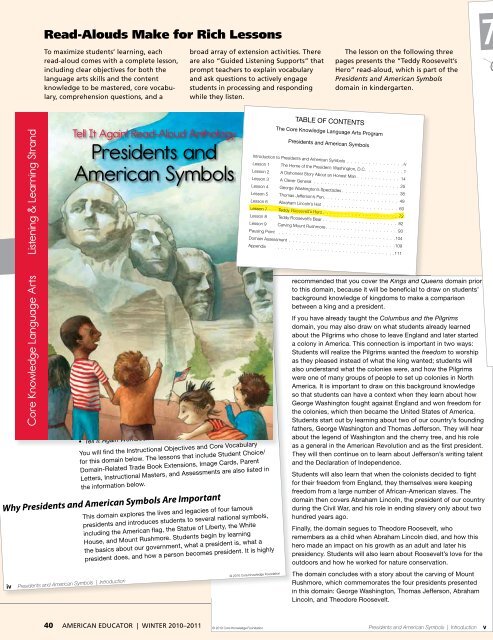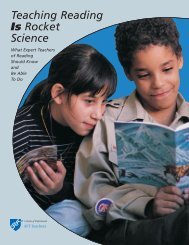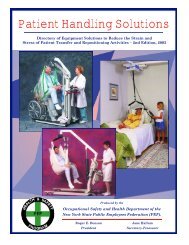American Educator, Winter 2010-11, Vol. 34, No. 4, AFT
American Educator, Winter 2010-11, Vol. 34, No. 4, AFT
American Educator, Winter 2010-11, Vol. 34, No. 4, AFT
Create successful ePaper yourself
Turn your PDF publications into a flip-book with our unique Google optimized e-Paper software.
Core Knowledge Language Arts Listening & Learning Strand<br />
Read-Alouds Make for Rich Lessons<br />
To maximize students’ learning, each<br />
read-aloud comes with a complete lesson,<br />
including clear objectives for both the<br />
language arts skills and the content<br />
knowledge to be mastered, core vocabulary,<br />
comprehension questions, and a<br />
Tell It Again! Read-Aloud Anthology<br />
Presidents and<br />
<strong>American</strong> Symbols<br />
Introduction to Presidents<br />
and <strong>American</strong> Symbols<br />
40 AMERICAN EDUCATOR | WINTER <strong>2010</strong>–20<strong>11</strong><br />
broad array of extension activities. There<br />
are also “Guided Listening Supports” that<br />
prompt teachers to explain vocabulary<br />
and ask questions to actively engage<br />
students in processing and responding<br />
while they listen.<br />
This introduction includes the necessary background information<br />
to be used in teaching the Presidents and <strong>American</strong> Symbols<br />
domain. The Tell It Again! Read-Aloud Anthology for Presidents<br />
and <strong>American</strong> Symbols contains nine daily lessons, each of<br />
which is composed of two distinct parts, so that the lesson may<br />
be divided into smaller chunks of time and presented at different<br />
intervals during the day. The entire lesson will require a total of fi fty<br />
minutes.<br />
We have included one Pausing Point in this domain, after<br />
Lesson 9. You may wish to pause and spend one to two days<br />
reviewing, reinforcing, or extending the material taught prior to the<br />
Pausing Point. You should spend no more than eleven days total<br />
on this domain.<br />
Along with this anthology, you will need:<br />
• Tell It Again! Media Disk or the Tell It Again! Flip Book for<br />
Presidents and <strong>American</strong> Symbols<br />
• Tell It Again! Image Cards for Presidents and <strong>American</strong> Symbols<br />
•<br />
Tell Tell It Again Again Workbook Workbook for for Presidents Presidents and and <strong>American</strong> <strong>American</strong> Symbols Symbols<br />
You will fi nd nd the the Instructional Instructional Objectives Objectives and and Core Core Vocabulary<br />
Vocabulary<br />
for this domain below. The lessons that include Student Choice/<br />
Domain-Related Trade Book Extensions, Image Cards, Parent<br />
Letters, Instructional Masters, and Assessments are also listed in<br />
the information below.<br />
CVR_Pres.indd 1 6/2/<strong>2010</strong> 5:30:09 PM<br />
Why Presidents and <strong>American</strong> Symbols Are Important<br />
© <strong>2010</strong> Core Knowledge Foundation<br />
This domain explores the lives and legacies of four famous<br />
presidents and introduces students to several national symbols,<br />
including the <strong>American</strong> fl ag, the Statue of Liberty, the White<br />
House, and Mount Rushmore. Students begin by learning<br />
the basics about our government, what a president is, what a<br />
president does, and how a person becomes president. It is highly<br />
iv Presidents and <strong>American</strong> Symbols | Introduction © <strong>2010</strong> Core Knowledge Foundation<br />
© <strong>2010</strong> Core Knowledge Foundation<br />
TABLE OF CONTENTS<br />
The Core Knowledge Language Arts Program<br />
Presidents and <strong>American</strong> Symbols<br />
The lesson on the following three<br />
pages presents the “Teddy Roosevelt’s<br />
Hero” read-aloud, which is part of the<br />
Presidents and <strong>American</strong> Symbols<br />
domain in kindergarten.<br />
Introduction to Presidents and <strong>American</strong> Symbols . . . . . . . . . . . . . . . . iv<br />
Lesson 1 The Home of the President: Washington, D.C. . . . . . . . . . . 1<br />
Lesson 2 A Dishonest Story About an Honest Man . . . . . . . . . . . . 14<br />
Lesson 3 A Clever General . . . . . . . . . . . . . . . . . . . . . . . . 25<br />
Lesson 4 George Washington’s Spectacles . . . . . . . . . . . . . . . . 38<br />
Lesson 5 Thomas Jefferson’s Pen. . . . . . . . . . . . . . . . . . . . . 49<br />
Lesson 6 Abraham Lincoln’s Hat . . . . . . . . . . . . . . . . . . . . . 60<br />
Lesson Lesson Lesson Lesson 7 7 7 7 Teddy Teddy Teddy Teddy Roosevelt’s Roosevelt’s Roosevelt’s Roosevelt’s Hero Hero Hero Hero . . . . . . . . . . . . . . . . . . . . . . . . . . . . . . . . . . . . . . . . . . . . . . . . . . . . . . . . . . . . . . . . . . . . . . . . . . . . . . . . . . . . 72 72 72<br />
72<br />
Lesson 8 Teddy Roosevelt’s Bear . . . . . . . . . . . . . . . . . . . . . 82<br />
Lesson 9 Carving Mount Rushmore . . . . . . . . . . . . . . . . . . . . 93<br />
Pausing Point . . . . . . . . . . . . . . . . . . . . . . . . . . . . . . . . .104<br />
Domain Assessment . . . . . . . . . . . . . . . . . . . . . . . . . . . . . .109<br />
Appendix . . . . . . . . . . . . . . . . . . . . . . . . . . . . . . . . .<strong>11</strong>1<br />
recommended that you cover the Kings and Queens<br />
domain prior<br />
to this domain, because it will be benefi<br />
cial to draw on students’<br />
background knowledge of kingdoms to make a comparison<br />
between a king and a president.<br />
If you have already taught the<br />
Columbus and the Pilgrims<br />
domain, you may also draw on what students already learned<br />
about the Pilgrims who chose to leave England and later started<br />
a colony in America. This connection is important in two ways:<br />
Students will realize the Pilgrims wanted the<br />
freedom to worship<br />
as they pleased instead of what the king wanted; students will<br />
also understand what the colonies were, and how the Pilgrims<br />
were one of many groups of people to set up colonies in <strong>No</strong>rth<br />
America. It is important to draw on this background knowledge<br />
so that students can have a context when they learn about how<br />
George Washington fought against England and won freedom for<br />
the colonies, which then became the United States of America.<br />
Students start out by learning about two of our country’s founding<br />
fathers, George Washington and Thomas Jefferson. They will hear<br />
about the legend of Washington and the cherry tree, and his role<br />
as a general in the <strong>American</strong> Revolution and as the fi<br />
rst president.<br />
They will then continue on to learn about Jefferson’s writing talent<br />
and the Declaration of Independence.<br />
Students will also learn that when the colonists decided to fi<br />
ght<br />
for their freedom from England, they themselves were keeping<br />
freedom from a large number of African-<strong>American</strong> slaves. The<br />
domain then covers Abraham Lincoln, the president of our country<br />
during the Civil War, and his role in ending slavery only about two<br />
hundred years ago.<br />
Finally, the domain segues to Theodore Roosevelt, who<br />
remembers as a child when Abraham Lincoln died, and how this<br />
hero made an impact on his growth as an adult and later his<br />
presidency. Students will also learn about Roosevelt’s love for the<br />
outdoors and how he worked for nature conservation.<br />
The domain concludes with a story about the carving of Mount<br />
Rushmore, which commemorates the four presidents presented<br />
in this domain: George Washington, Thomas Jefferson, Abraham<br />
Lincoln, and Theodore Roosevelt.<br />
Presidents and <strong>American</strong> Symbols | Introduction iii<br />
Presidents and <strong>American</strong> Symbols | Introduction v<br />
7





